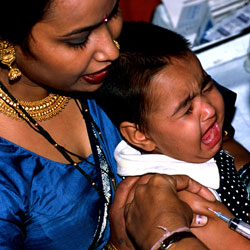Vaccines must reach more children
July / August 2012 | Volume 11, Issue 4

Photo by Ernie
Branson, NIH
Dr. Seth Berkley
The power of vaccines to prevent deaths is immense, especially in children, and access must be extended globally, particularly in sub-Saharan Africa and Southeast Asia, said Dr. Seth Berkley, CEO of the GAVI Alliance that works to improve vaccine access in low- and middle-income countries.
"Vaccines have helped bring a huge decrease in child deaths," he said, noting that annual deaths fell to 7.6 million in 2010 from 12 million in 1990. "But 7.6 is 7.6 too many. Twenty-one thousand children die every day."
Berkley recently spoke at the NIH's John Ring LaMontagne Memorial Lecture. Immunizing children and preventing illness has numerous benefits, aside from directly protecting the child, he said. These include:
- Healthy children do better at school
- Families have fewer out-of-pocket expenses
- Parents lose less work time and income caring for sick children
- Couples conceive fewer children if they expect them to survive to adulthood

Photo by P. Virot/WHO
Many children in developing countries do not yet
have access to life-saving vaccines. The GAVI
Alliance, a private-public partnership, raises funds
to supply vaccines and since 2000 has reached
more than 326 million children.
The two largest killers of children in the world's 73 poorest countries are pneumonia and diarrheal diseases, at 24 percent and 18 percent of all deaths, respectively. Yet vaccines exist to protect against both, Berkley said, noting that GAVI has made supplying these vaccines - pneumococcal and rotavirus - its top priority. For instance, the group plans to have provided the rotavirus vaccine to 50 million children by 2015.
In its program to date, GAVI has orchestrated the vaccination of more than 325 million children. To extend this number, the group continues to arrange special pricing plans with manufacturers and to enlist the help of officials in the affected countries. Vaccination programs, when established, can be "a wedge into the health system and strengthen outreach" for other health programs, he said.
However, GAVI's vaccine program faces many challenges, not least in vaccine costs. Other threats include disinformation circulating on the Internet that scares people away from vaccines and a potential ban on mercury by the United Nations, which would affect mercury-derived thimerosal currently used as a low-cost preservative in some vaccines.
GAVI vaccines reach more children
The GAVI Alliance continues to increase the number of children who have access to vaccines that can save their lives. By the end of 2011, it reported the following:
- 296 million children were immunized against hepatitis B
- 124 million children were protected against Haemophilus influenza type b (Hib), the virus that causes deadly forms of meningitis and pneumonia
- 54 million children have received yellow fever vaccine
- 50 million children will receive rotavirus vaccines in 40 countries by 2015
"Overcoming the obstacles to universal access to immunization will require the political will to make vaccine access a right for every child, to spur innovations in vaccine delivery and to ensure support from finance ministries to prioritize vaccines in national budgets," Berkley said.
The John Ring LaMontagne Memorial Lecture honors contributions to NIH and public health made by LaMontagne during his 30-year career with the National Institute of Allergy and Infectious Diseases.
More Information
To view Adobe PDF files,
download current, free accessible plug-ins from Adobe's website.